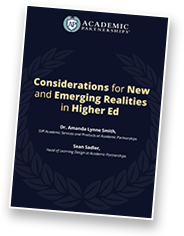Faced with the threat of a global pandemic during the 2020 spring semester, the twin operational orthodoxies of on-campus instruction for traditional students and online instruction for non-traditional students were suddenly disrupted, leaving institutional leaders scrambling to continue classes via remote teaching and video conferencing. In COVID-19’s wake, preparation for fall semester classes also faces uncertainty.
The emerging reality: Universities who are self-aware must not only prepare sustainable contingency plans, but act to more permanently align a far-reaching spectrum of program planning, course delivery and faculty expertise to give students the level of instruction they demand and pay to receive.
This white paper examines these higher education incumbencies and guides leadership in an approach to embracing new options—first reviewing the nature of change and necessity for re-invention; then discussing new definitions for education modalities and their role in goal-setting; and lastly, helping define what is meant by minimum viable product (MVP) and establishing the necessity for facilitating tiered professional development to meet institutional goals.
Steps being taken by exemplar universities provide real-world insights into the practical possibilities of incorporating fully grown online modalities into contingency and future planning. The all-encompassing reality is that now is the moment for universities to pivot toward longer-term growth goals by applying intentional strategies and instructional models that will help them survive and thrive in times to come.
